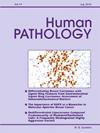解锁诊断潜力:近1000例外科病理标本中GPNMB免疫组化的回顾性分析
IF 2.7
2区 医学
Q2 PATHOLOGY
引用次数: 0
摘要
糖蛋白非转移性黑色素瘤蛋白B (GPNMB)是一种受TSC/mTOR-TFE通路调节的溶酶体跨膜蛋白,已被提出作为与TSC/mTOR-TFE通路改变相关的肿瘤的诊断免疫组织化学(IHC)标志物。然而,其在常规外科病理中的诊断作用尚未得到系统的大规模评价。我们回顾性地回顾了约翰霍普金斯大学病理档案(2021-2025)中进行GPNMB IHC的934例病例。诊断分为TSC/mTOR- tfe相关、非TSC/mTOR/ tfe相关或未定义的分子群。与荧光原位杂交(FISH)结果和组织学特征的相关性来评估诊断的实用性。GPNMB在94.8%(218/230)的TSC/ mtor - tfe相关肿瘤中呈弥漫性阳性,包括TFE3/TFEB重排的肾细胞癌、血管周围上皮样细胞瘤(PECOMA/AML)和其他相关实体。相比之下,83.3%的非tsc / mtor - tfe相关肿瘤的GPNMB呈阴性。两组中均出现不一致的病例,可能反映了分子异质性、FISH的局限性或GPNMB表达的复杂调控。在fish确诊的TFE3或TFEB改变病例中,GPNMB的敏感性优于组织蛋白酶K。斑片状或模糊染色需要仔细的组织学和辅助相关性来解释。GPNMB免疫组化是诊断TSC/ mtor - tfe相关肿瘤的一种有价值的辅助工具,特别是在肾脏和间质肿瘤中。虽然没有完全的特异性或敏感性,但它提供了快速和经济的分子检测替代方案,可以指导进一步的诊断工作。在没有已知TSC/mTOR-TFE改变的肿瘤中,GPNMB阳性染色可能提示继发性通路参与,需要进一步的分子研究。本文章由计算机程序翻译,如有差异,请以英文原文为准。
Unlocking diagnostic potential: A retrospective analysis of GPNMB immunohistochemistry in nearly 1000 surgical pathology specimens
Glycoprotein non-metastatic melanoma protein B (GPNMB) is a lysosomal transmembrane protein regulated by the TSC/mTOR-TFE pathway and has been proposed as a diagnostic immunohistochemical (IHC) marker for tumors associated with TSC/mTOR-TFE pathway alterations. However, its diagnostic performance in routine surgical pathology has not been systematically evaluated on a large scale. We retrospectively reviewed 934 cases from the Johns Hopkins pathology archives (2021–2025) in which GPNMB IHC was performed. Diagnoses were categorized into TSC/mTOR-TFE-related, non-TSC/mTOR/TFE-related, or undefined molecular groups. Correlation with fluorescence in situ hybridization (FISH) results and histologic features was performed to assess diagnostic utility. GPNMB was diffusely positive in 94.8 % (218/230) of TSC/mTOR-TFE-related neoplasms, including renal cell carcinomas with TFE3/TFEB rearrangements, perivascular epithelioid cell tumors (PECOMA/AML), and other related entities. In contrast, 83.3 % of non-TSC/mTOR-TFE-related tumors were negative for GPNMB. Discordant cases were seen in both groups, likely reflecting molecular heterogeneity, limitations of FISH, or the complex regulation of GPNMB expression. GPNMB outperformed cathepsin K in sensitivity in FISH-confirmed cases with TFE3 or TFEB alterations. Patchy or equivocal staining required careful histologic and ancillary correlation for interpretation. GPNMB IHC is a valuable ancillary tool in diagnosing TSC/mTOR-TFE-related neoplasms, particularly in renal and mesenchymal tumors. While not perfectly specific or sensitive, it offers a rapid and cost-effective alternative to molecular testing and can guide further diagnostic workup. Positive GPNMB staining in tumors without known TSC/mTOR-TFE alterations may suggest secondary pathway involvement, warranting additional molecular studies.
求助全文
通过发布文献求助,成功后即可免费获取论文全文。
去求助
来源期刊

Human pathology
医学-病理学
CiteScore
5.30
自引率
6.10%
发文量
206
审稿时长
21 days
期刊介绍:
Human Pathology is designed to bring information of clinicopathologic significance to human disease to the laboratory and clinical physician. It presents information drawn from morphologic and clinical laboratory studies with direct relevance to the understanding of human diseases. Papers published concern morphologic and clinicopathologic observations, reviews of diseases, analyses of problems in pathology, significant collections of case material and advances in concepts or techniques of value in the analysis and diagnosis of disease. Theoretical and experimental pathology and molecular biology pertinent to human disease are included. This critical journal is well illustrated with exceptional reproductions of photomicrographs and microscopic anatomy.
 求助内容:
求助内容: 应助结果提醒方式:
应助结果提醒方式:


